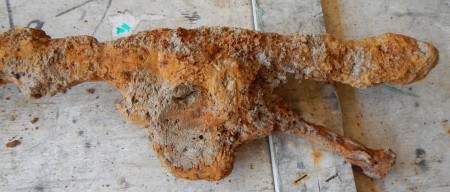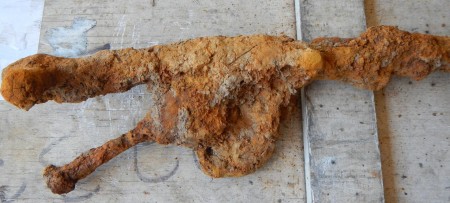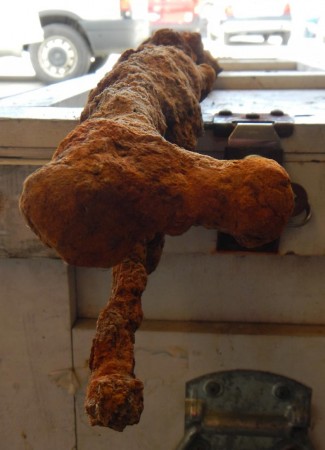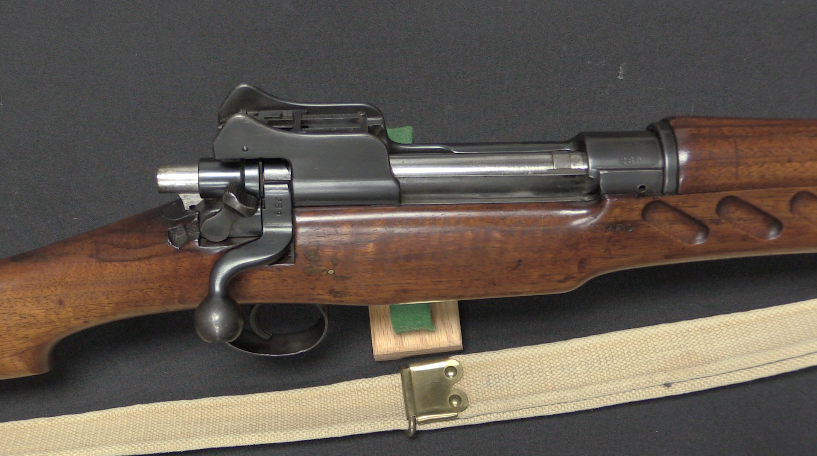One of our European correspondents, Bart, sent over a couple photos of a rifle excavated recently at the Ypres battlefield, looking to confirm an identification. Since we know some of the history behind it by virtue of where it was found, this one turns out to be a relatively simple process of elimination to identify, despite its horrendous condition.
First off, we know that it must be a WWI military weapon of some type. That narrows the field down substantially.
Next, we can look to the most distinctive feature present: the protrusion angled down at the left end. That is undoubtedly the bolt that attaches the butt end of a two-piece stock to the receiver. The French Lebel and British Lee series of rifles both used two-piece stocks, but only the Lee used a long bolt like that to attach the butt (the Lebel used a bolt running crosswise instead).
The first thought is that this makes the gun an typical No1 Mk III (or MkIII*) SMLE – but the muzzle end doesn’t really match that conclusion. The SMLE had a large nosecap with the front sight, mounted right at the end of the barrel. This rifle appears to have the front sight set back a bit, and there is no evidence of a nosecap assembly. So what Lee rifle does that fit with? The MkI Lee-Metford, also known as the Long Lee. Those rifles had a set back and unadorned front sight, which fits with what we see here. Lee-Metford rifles were rebarreled in large numbers and issued in WWI to supplement the production of new SMLE rifles, and there are several sources specifically mentioning Metfords at Ypres.
One issue that Bart raised was how the bolt handle appeared to be horizonal and retracted, suggesting a straight-pull action, or possibly a bolt handle dramatically bent out of shape. That would be true with a Mauser or Lebel rifle, but the Lee actually fits this detail. The bolt handle of the Lee-Metford (and later Lee-Enfield rifles) was turned down, and in addition its throw to operate was about 60 degrees instead of the Mauser’s 90 degrees. These two facts together mean that when a Metford bolt is open, the handle sits horizontal – just like we see in the photos here. Here is a good picture of an intact Lee-Metford showing this well.







look like a fishing rod..
I think the rifle have been really distorded…
maybe a berthier variant with this bolt system ?
Bart could confirm your analysis by having the receiver area X-rayed at a welding QC shop. Should not cost much and the image would be a nice supplement to the artifact if it goes to a museum or a collector.
Who is up for a restoration project? looks like it could b a nice shooter 😉
In all seriousness though, what would you do to this to make it into a museum piece? Try and remove some of the corrosion to better represent the true shape, or just treat it with some sort of preservative (polymer resin to penetrate and seal maybe?) and leave as-is? I cannot imagine that there is a lot of un-oxidized metal left, so complete removal of the corrosion would probably not leave you with much, but at the same time it is not immediately recognizable in its current shape.
I believe soaking it in a chelating agent would be the way to go. A chelating agent would only remove the oxidized iron, unlike an acid which attacks both the oxidized and unoxidized iron. Since the process works slowly, it could be monitored and removed from the chelating agent when it was felt that enough oxidation had been removed.
David
The poor things nearly entirely rotted away, a sunken skeleton…
http://www.rifleman.org.uk/The_Rifle_Short_Magazine_Lee-Enfield_main.htm#Charger_Loading
I agree with Ian’s conclusion, after looking at some drawings. It’s looks “droopy” maybe it was buried in a kind of upright position. I say that as the front barrel band has is further down like the rear one, so when the wood rotted away the metal slid down… Kind of makes you think of the owner sliding away behind it, into a trench. My great uncle was killed at Ypres in 1915 an Irish fella, apparently they lost 300 a day aside from the main attacks just general losses.
Mind you, the lump which would presumably be the forward barrel band, could be the front cap off a smellie as the sight was attached to the barrel apparently. So it could have slid in a slumped position, the magazine etc all appear to have drooped into each other. 100 years ago this year, is the centenary of the outbreak of the war to end all wars the great war for civilization as it was termed…
Although the front sight does appear to be more “Those rifles had a set back and unadorned front sight, which fits with what we see here” set back as mentioned by the author.
How’s the bore look?
LOL
Very likely a tragic tale associated with that relic. My grandfather was a Marine who served at Belleau Wood at the end of WW1. He rarely talked about it, other than to say how horrible it all was. I have a lot of old weapons lying around, and every time I pick one up, I realize that it once was borne by someone whose life was forever changed (or ended) when they carried it in the field. Bless them all, and may they now know the peace that eluded them in life.
Sorry to nitpick, but the SMLE was the No 1 Mk 3 (or 3*), not No 3 Mk 1.
Whoops! That was a typo, which I have fixed. Thanks!
Musn’t restore it to much otherwise he’ll need a licence (gun club or hunting) in order to keep it.Although the lee metford should be classed in D2 (considered an antique thus no licence needed)but what the rebarreling does to this classification I don’t know I saw a picture of a very well restored maxim digup that had to be neutralized in spite of the fact that it was incabable of firing VIVE LA FRANCE
The Metford and the Enfield are different rifles by designation and by barrel pattern – whilst the old black powder rifling didn’t wear out overnight with cordite rounds, very unlikely that any Lee-Metfords would still have been on issue by 1914 – this will be a Long Lee. Also, the No.1 designation is a post-war one.
Well I always thought the Metford was a long Lee personally, not that I’m an expert. You Sir, are a stickler for accuracy he he.
Still it’s not a SMLE…
It probably matters more to us Brits – of they hadn’t named the original after Metford, they would probably just have made it ‘Lee Magazine Rifle Mk.II’. The only difference you can see in photos is the Mauser-style finger grooves in the stock, deleted on the Enfield.
This Canadian, person… Who’s possibly something of a maniac, mind you that’s why we don’t speak ze German, has a video of the Metford.
http://www.youtube.com/results?search_query=long+lee+enfield
I assume he’s Canadian unless he just doesn’t like George Washington but lives in Virginia.
This fellow rather,
http://www.youtube.com/watch?v=uKHz0DLmrfA